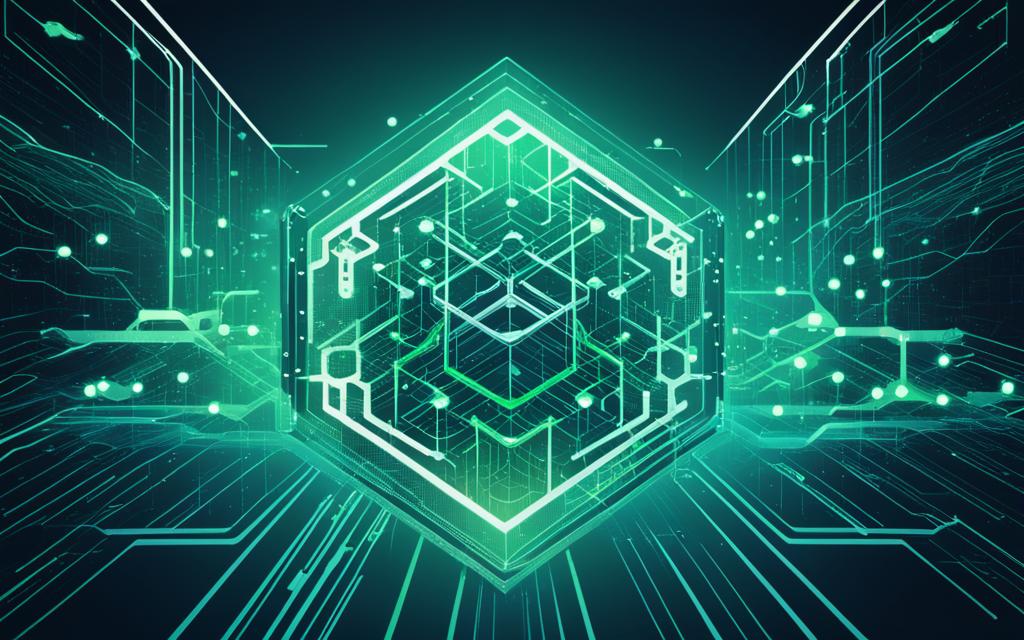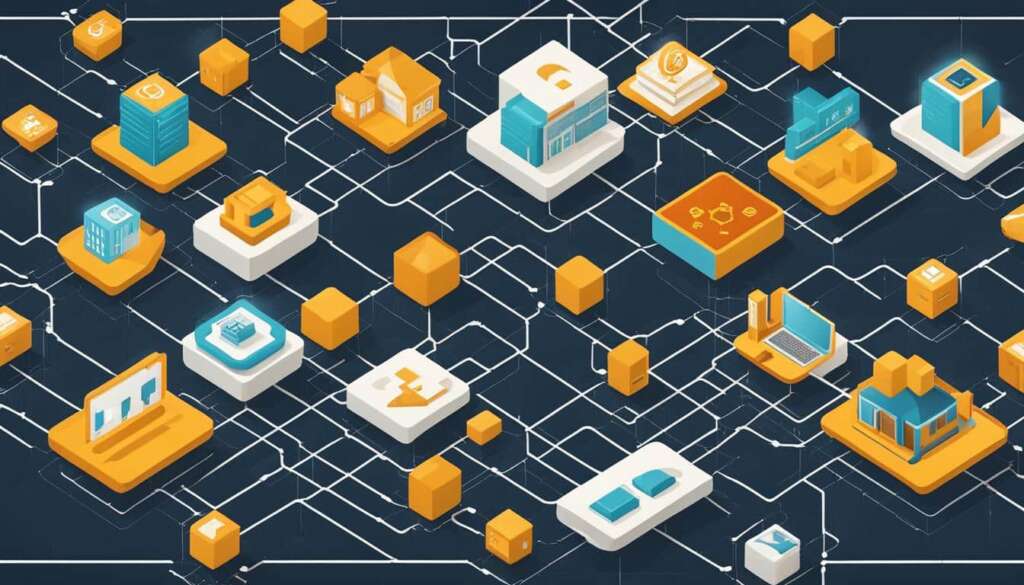Table of Contents
To understand transaction verification, you need to know about blockchain technology. A blockchain is like a digital ledger, recording every transaction. For a transaction to be accepted, miners, a group of network participants, must verify it. They do this by solving complex math problems using powerful computers. Once verified, the transaction is added to the blockchain. This ensures the network’s security and trust.
Bitcoin’s total supply is capped at 21 million, estimated to be reached by 21401. This limit adds value and potential to Bitcoin. Mining started with regular computer chips but now uses specialized equipment called ASICs due to increased complexity1. This progress shows how mining in the cryptocurrency space has become more advanced over time.
A Bitcoin block needs many calculations to be verified. The difficulty of these calculations changes every 2,016 blocks. The system aims to maintain a ten-minute confirmation time per block1. Miners are awarded Bitcoin for their work, but this reward halves every 210,000 blocks1. By doing this, the system ensures there won’t be more than 21 million bitcoins. It also motivates miners to keep the network secure.
Ethereum, on the other hand, requires users to pay a fee in ether (ETH) to execute transactions. This fee varies depending on the transaction’s complexity1. It prevents network congestion and misuse of the Ethereum blockchain. Nodes on the Ethereum network hold important data, like transaction history and smart contract details. This data storage makes the Ethereum blockchain reliable and secure.
Key Takeaways:
- Transactions on a cryptocurrency network like Bitcoin or Ethereum are verified by a network of participants called miners.
- Bitcoin has a limited supply of 21 million bitcoins, contributing to its value and long-term potential.
- Bitcoin mining has evolved from consumer-grade computing chips to specialized ASIC chips.
- Ethereum users pay transaction fees in ether to prevent network abuse.
- Nodes on the Ethereum network store critical information for enhanced reliability and security.
The Role of Miners in Transaction Verification
Miners are vital in checking transactions on cryptocurrency networks. Every transaction must be added to a batch with others. Miners then work to confirm these batches by solving tough math puzzles.
The first to solve these puzzles gets digital money as a reward. This ensures transactions are right and safe. It’s a key part of how cryptocurrencies work.
Once, lots of people were into mining because it could be very profitable. This high demand made a big GPU maker, Advanced Micro Devices, very popular.
Yet, as cryptocurrencies like Bitcoin get harder to mine, the rush has slowed. This means it’s not as easy to make a quick profit from mining anymore2.
Using a special type of mining machine, a miner might need 72 terawatts of power to make a bitcoin. This takes about ten minutes2.
The speed all miners work together at is massive, billions of billions of calculations every second. It shows how much energy and effort mining takes3.
Remember, miners are not just about transactions. They help keep the whole system safe and make new coins. But, some worry that a few very big mining groups might hurt the fairness of the system4.
When miners sell the digital coins they’ve earned, taxes might be due. In Israel, mining is taxed like a regular business. But in places like India, the rules are under debate2.
All miners get paid in two ways: they earn some new crypto coins, and they get a fee for each transaction they help make secure4.
There’s a limit to how many bitcoins can ever be made: 21 million. After that, miners will earn from the fees people pay to use the system3.
So, mining keeps growing more challenging. On a specific day, the odds of finding the right answer to a mining problem were one in 88.1 trillion3.
Also, keeping 51% of the mining power means someone could attack the system. This is a major worry because fixing it would be hard and costly4.
The Consensus Algorithm and Network Nodes
In a cryptocurrency network, the consensus algorithm is vital. It ensures transactions are valid and the network remains trustworthy. Key to this are the network nodes. They check transactions and keep the network decentralized.
It sets rules for all nodes to agree on the network’s status. These rules check every transaction to make sure they’re safe and honest. This way, all info added to the blockchain is reliable.
Nodes are essential. They confirm and share transaction details. Miners and non-miners can be network nodes. Each adds to the network’s safety and dependability.
Nodes verify transaction details, stopping fake deals or using money twice. They make sure everything about a transaction is okay before saving it to the blockchain.
Miners do more. They must solve tricky math problems in mining. This needs a lot of computer power and energy. In return, they earn digital coins and fees for their work.
In mining, miners rush to solve puzzles for a reward. The first who solves it, gets the reward. This encourages them to keep the network safe and active.
Bitcoin’s success is partly due to mining. Still, mining faces problems like the reward getting lower over time. This is called the halving. Plus, there’s the danger of a 51% attack, where a few people can control the network danger, as5 explains.
Even with issues, algorithms like PoW and PoS help protect the network. PoS, highlighted in6, is a greener and cheaper way than PoW. Validators bet their coins to win the chance to add blocks.
In the end, the consensus algorithm and nodes are crucial in cryptocurrencies. They make transactions honest, keep the network open, and secure. Whether using PoW, PoS, or others, these methods are key for any cryptocurrency network.
The Proof of Work Mechanism
The proof of work is vital to many cryptocurrencies, like Bitcoin and Ethereum 1.0. It checks transactions on the network to ensure they are valid, all without a central authority. Hal Finney’s idea was key. It made Bitcoin the first big user of the proof of work in 20097.
This method has miners solve hard maths puzzles, known as hashing algorithms, to check transaction blocks. These puzzles show miners have used a lot of computer power and energy to protect the network. The puzzle difficulty changes to keep the network running well7.
The proof of work has many pluses for the cryptocurrency world. It spreads the work across many miners, stopping one from controlling most transactions. This setup helps keep the blockchain safe. It makes it very hard for anyone to change the transaction history. Also, it stops users from spending the same cryptocurrency twice7.
But, the proof of work also has downsides. People criticise it for using a lot of electricity. By May 2024, miners for Bitcoin faced a tough challenge. They aimed for 83.148T hashes per second each. FoundryDigital had the most hashing power, with 175 EH/s out of 673 EH/s7. This energy use pushes us to look for greener, more efficient ways to check transactions.
| Proof of Work Cryptocurrencies |
|---|
| Bitcoin |
| Dogecoin |
| Bitcoin Cash |
| Litecoin |
| Monero |
Almost 64% of cryptocurrency value comes from those using proof of work8. However, this method can lead to mining control by a few big players. They might then control a big part of cryptocurrency operations8. That’s why newer cryptos like Ethereum 2.0, Cardano, and Tezos are moving to proof of stake. This change aims to make things fairer and less centralised9.
Even with its issues, the proof of work is a key part of crypto. Its way of working makes blockchain networks secure and not easily attacked. But, the crypto world is always looking for better ways. Proof of stake is one path being explored to deal with proof of work’s limitations9.
References:
- Proof of Work – Investopedia
- Proof of Work – Forbes
- What is Proof of Work or Proof of Stake? –
Advantages and Challenges of Proof of Work
Proof of Work (PoW) is a key way cryptocurrencies decide who adds new transactions to the digital ledger. This method helps make transactions secure and stops the same money being spent twice. However, using PoW also brings up some issues that the industry must deal with.
Advantages of Proof of Work
PoW makes sure cryptocurrency transactions are safe. It does this by making miners solve hard puzzles. This process is tough for bad actors to change the transaction history. So, it helps keep cryptocurrencies trustworthy and clear.
Many well-known cryptocurrencies, like Bitcoin and Litecoin, use PoW. This shows it’s a reliable way of working. It’s known and trusted by lots of people.
PoW also helps keep the cryptocurrency world fair. With PoW, no one person or group can control all the mining power. This stops any one place from taking over and making the rules.
In PoW, miners get rewards for their work. They earn bitcoins and fees for their part in keeping the blockchain safe.
Challenges of Proof of Work
Energy use in PoW is a big issue. Mining coins uses a lot of power. This can harm the environment and add to carbon emissions.
Mining can also be slow. Some transactions take a while to go through. During busy times, this can slow everything down more. It makes it hard for cryptocurrencies to grow fast.
There’s a small chance, but still a chance, one group could control over half the mining power. This could let them cheat the system. Even though it’s not an easy thing to do because of how PoW works, it’s still a problem to think about.
PoW also demands a lot in resources. It needs strong computers and a lot of money. This makes it hard for some people to join in.
But there’s hope. People are looking for new ways, like Proof of Stake, to make things better in the future.
| Advantages | Challenges |
|---|---|
|
|
“Proof of Work makes transactions secure by having miners solve hard puzzles. This keeps cryptocurrencies trustworthy. Yet, the method uses a lot of energy, can be slow, faces a 51% attack risk, and requires lots of resources. These are issues that must be tackled.”1011.
Alternative Verification Systems
Developers are creating new systems to tackle the issues with proof of work. They’ve come up with proof of stake and proof of history. These aim to use less energy and be faster than proof of work. They offer new ways to check transactions and reach agreement in a blockchain. This might help fix some of the problems with proof of work.
Proof of stake (PoS) chooses proofers based on the amount of coins they have. Unlike proof of work that uses a lot of power, PoS allows people to create new blocks by having a stake in the network. So, the more coins you have, the better your chance of making the next block. This way of working uses less energy. It’s focused on how much of the network you own. This makes it greener than proof of work12.
There’s also proof of history (PoH), a new way to agree on the order of events. It uses a special function to make sure time is verified and events happen in the right order. This means transactions are accurate without needing lots of computing power. PoH has the potential to make blockchains work better by making them more scalable and efficient. It’s a new and exciting direction for blockchain technology13.
These new systems not only help with the energy problem and slow transactions but they also make the network more secure. In proof of stake, validators need to have a certain amount of cryptocurrency. This stops people from bad behaviour. Plus, PoS can add more security to make sure only honest validators work on the network. This way it’s more trusted12.
Blockchain experts are always looking for new and better ways to check transactions and agree on things. These steps in blockchain technology can lead to more improvements. They can make decentralised networks better for the long run. Using these new methods can help blockchains grow and be better for the environment12.

| Comparison of Verification Systems | Proof of Work (PoW) | Proof of Stake (PoS) | Proof of History (PoH) |
|---|---|---|---|
| Energetic efficiency | High energy consumption14 | Significantly reduces energy consumption12 | Offers potential for energy efficiency13 |
| Transaction verification times | Slow14 | Dependent on stake12 | Potentially faster13 |
| Security measures | Relies on computational power14 | Requires ownership of cryptocurrency12 | Relies on verifiable order of events13 |
The Importance of Transaction Verification for Cryptocurrency Investors
Keeping transactions safe is top priority in the cryptocurrency world. Investors need to trust every transaction. They use this trust to make money decisions and pick which cryptocurrencies to invest in. Blockchain, the tech behind cryptocurrencies, is very good at making sure everything is safe and correct.
The Proof of Work (PoW) method is a big part of checking transactions. It involves miners, the people who help run the cryptocurrency system. Miners work to solve hard puzzles, which then makes the system more secure. This usually takes about ten minutes to confirm a transaction15.
There’s also a newer way called Delegated Proof of Stake (DPoS). It makes checking transactions quicker and smoother. With DPoS, certain chosen nodes look after confirming transactions, making the whole process faster.
Miners are very important, especially in cryptocurrencies like Bitcoin. They use special computers to solve tough puzzles. By solving these puzzles, the miners keep Bitcoin’s transactions safe and trustworthy15.
Keeping transactions secure is not just about protecting money. It’s also about keeping people’s personal information safe. Many worry their personal details might get sold online. That’s why rules like Anti-Money Laundering (AML) and Know Your Customer (KYC) are very important in the cryptocurrency world16. They’re there to stop bad activities and keep personal info safe.
Encryption plays a big part in keeping transactions safe. It turns secret data into code that’s very hard to break. Also, using more than one method to check a person’s identity makes it much harder for hackers to get in17.
Checking transactions is key to stop cheating and fraud in the cryptocurrency network. With smart rules and technology, everyone helping to run the network makes sure money moves are real and safe17. This way, the cryptocurrency world stays secure and trusted.
In short, checking transactions is vital for anyone putting money in cryptocurrencies. Methods like Proof of Work and Proof of Stake, along with strong encryption and multiple ID checks, keep transactions safe. Knowing this helps investors make smart choices and support cryptocurrencies to grow.
| Statistical Data Reference | Description |
|---|---|
| 15 | Proof of Work (PoW) mechanism, miners, and average block confirmation time of ten minutes |
| 16 | Consumer concerns about personal information availability and the implementation of AML and KYC regulations |
| 17 | Miners’ rewards, encryption, multi-factor authentication, prevention of double-spending, and transaction logging in the blockchain |
The Future of Transaction Verification in Cryptocurrency Networks
Technological advancements are changing how transactions are verified in cryptocurrency networks. There’s a big push for change towards scalability, saving energy, and faster processes. This involves looking for new ways to handle the volume of transactions and improve the overall experience for users.
One method gaining attention is sharding. It breaks the blockchain into smaller pieces to handle transactions more quickly. This could make it easier to process a higher number of transactions, improving the user experience18.
Sidechains are also being developed. They work alongside the main blockchain, taking on part of the workload. This makes processing transactions faster and more efficient, benefiting the main blockchain’s scalability18.
Changing how we agree on transactions, or the consensus, is vital too. While Proof of Work (PoW) works well, it’s not great for the environment or scalable. That’s why we’re looking into other methods, like Proof of Stake (PoS) and Delegated Proof of Stake (DPoS), that could be more efficient and effective19.
PoS and DPoS involve users who hold coins helping to verify transactions. They aim to be more environmentally friendly than PoW. PBFT is a bit different, requiring most participating nodes to agree on a transaction’s validity19.
Saving energy and being sustainable are becoming key in blockchain development. We’re aiming to make systems that use less energy but still secure and spread out the responsibility. This will make blockchain more eco-friendly and lasting for the future.
Blockchain is being used beyond cryptocurrencies, in areas like secure transactions and voting. Its potential is vast, offering applications in product tracking, legal matters, and more. The way we verify transactions in cryptocurrency networks is changing and leading to new uses in various sectors18.
The future of verifying transactions in cryptocurrency networks looks bright. With new technology, solutions for scalability, and more efficient consensus methods, the era of blockchain is evolving. It will have a major impact on how we do transactions and more, offering a hopeful future for cryptocurrencies1819.
Conclusion
Transaction verification is key in the crypto world. It keeps transactions safe and confirms they’re honest. There are many steps, like starting the transaction, checking it, and then confirming it. This process stops double-spending and makes sure transactions are permanent20.
Things like wallet addresses and keys are crucial. They make sure money goes where it should smoothly and without errors20. Without needing middlemen, the security in transactions gets a big boost thanks to blockchain technology. This tech makes a clear, unchangeable record of transactions that everyone can trust20.
Crypto’s security comes from its verification process. This process is key in stopping fraud and keeping the blockchain secure20. It does this by adding transactions to the chain after making sure they’re genuine. However, verifying transactions this way uses a lot of power, faces risks of too much central control, and can be slow sometimes20. Finding ways to tackle these issues is important for making the system work better20.
Blockchain is making waves by not just changing money. It’s also helping in areas like education, healthcare, and food tracking21. For example, universities are now using blockchain to give out digital diplomas. Meanwhile, the food sector uses it to follow the journey of products from farm to table21. Today, the University of Melbourne in Australia is a great example of how blockchain checks the legitimacy of digital qualifications21.
Some key features of blockchain are its top-notch security and the fact that once something’s recorded, it can’t be changed. Adding things like digital signatures and special codes makes it even tougher for fraudsters to mess with transactions22. As blockchain gets better, its vital role in keeping crypto networks safe and running well will continue to grow2022.
FAQ
How are transactions verified on a cryptocurrency network?
Transactions on a cryptocurrency network get verified through a special process. It uses blockchain technology. This tech records all transactions in a digital ledger without a central authority.
Within this system, miners contribute their computing power. They solve tough math problems to secure and confirm transactions. Once a miner solves a problem, a transaction block is added to the blockchain.
What is the role of miners in transaction verification?
Miners have a vital job in making sure transactions are correct. They collect transactions into blocks and then check them. This checking process involves solving complex math puzzles.
The first miner to solve the puzzle wins new cryptocurrency. This rewards effort in verifying and securing network transactions.
What is the consensus algorithm and the role of network nodes?
The consensus algorithm is the network’s rulebook. It keeps everything running smoothly. Nodes, which can be miners or other users, check and share transaction details based on these rules.
So, the role of these nodes is crucial. They help verify and spread transaction information. This maintains the network’s trust and reliability.
What is the proof of work mechanism in cryptocurrency networks?
The proof of work mechanism is a key part of cryptocurrencies like Bitcoin. It helps verify transactions without a middleman. Here’s how it works – miners solve puzzles to confirm transaction blocks. This action stops users from spending the same cryptocurrency twice and keeps the network fair for all.
What are the advantages and challenges of proof of work?
Proof of work has its benefits and challenges. It stops double spending and makes transactions safe. But, it uses a lot of energy and can be risky if someone controls most mining power.
Are there alternative verification systems to proof of work?
Yes, there are new ways being explored to fix proof of work’s issues. Proof of stake and proof of history are some examples. They offer different ways to check transactions and reach agreement on the network’s state.
Why is transaction verification important for cryptocurrency investors?
For crypto investors, transaction verification is key. It ensures the network is safe and reliable. Knowing transactions are accurate helps investors make sound financial choices and understand a cryptocurrency’s true value.
What does the future hold for transaction verification in cryptocurrency networks?
Technology is always changing, and developers are looking for ways to make transaction verification better. They’re working on ideas like sharding and new consensus algorithms. These aim to improve the network’s size, energy use, and transaction speed.
Conclusion
Transaction verification is critical for cryptocurrency networks. It verifies transactions are secure and correct, laying the groundwork for future trust in cryptocurrency. With ongoing tech improvements, solutions to better process transactions are on the horizon.












